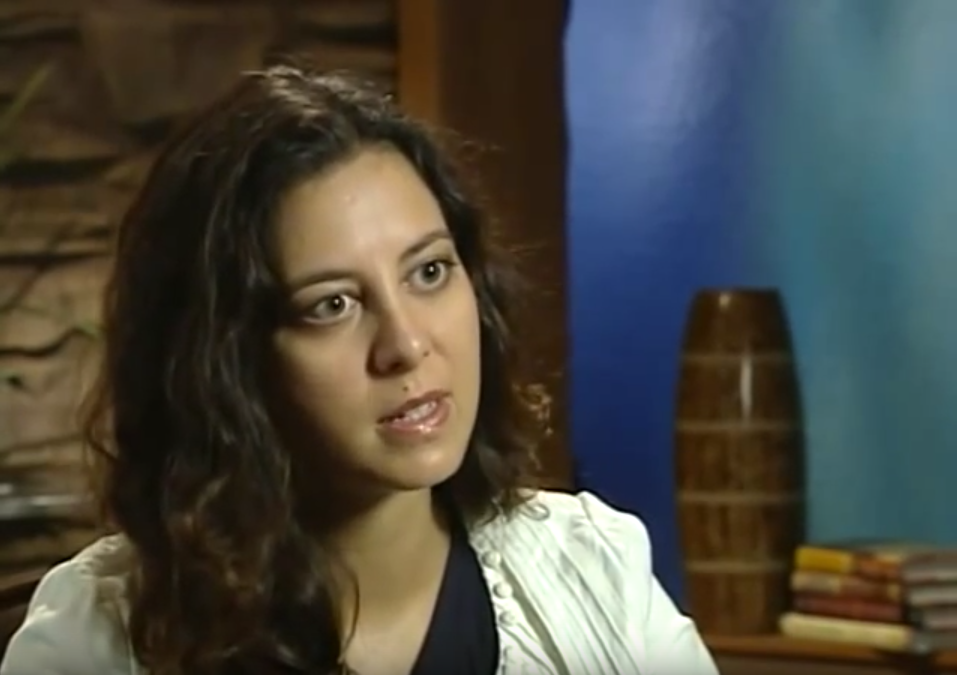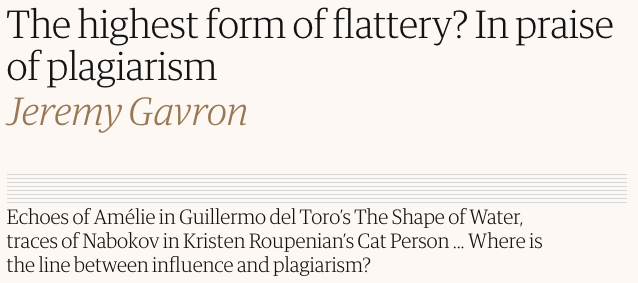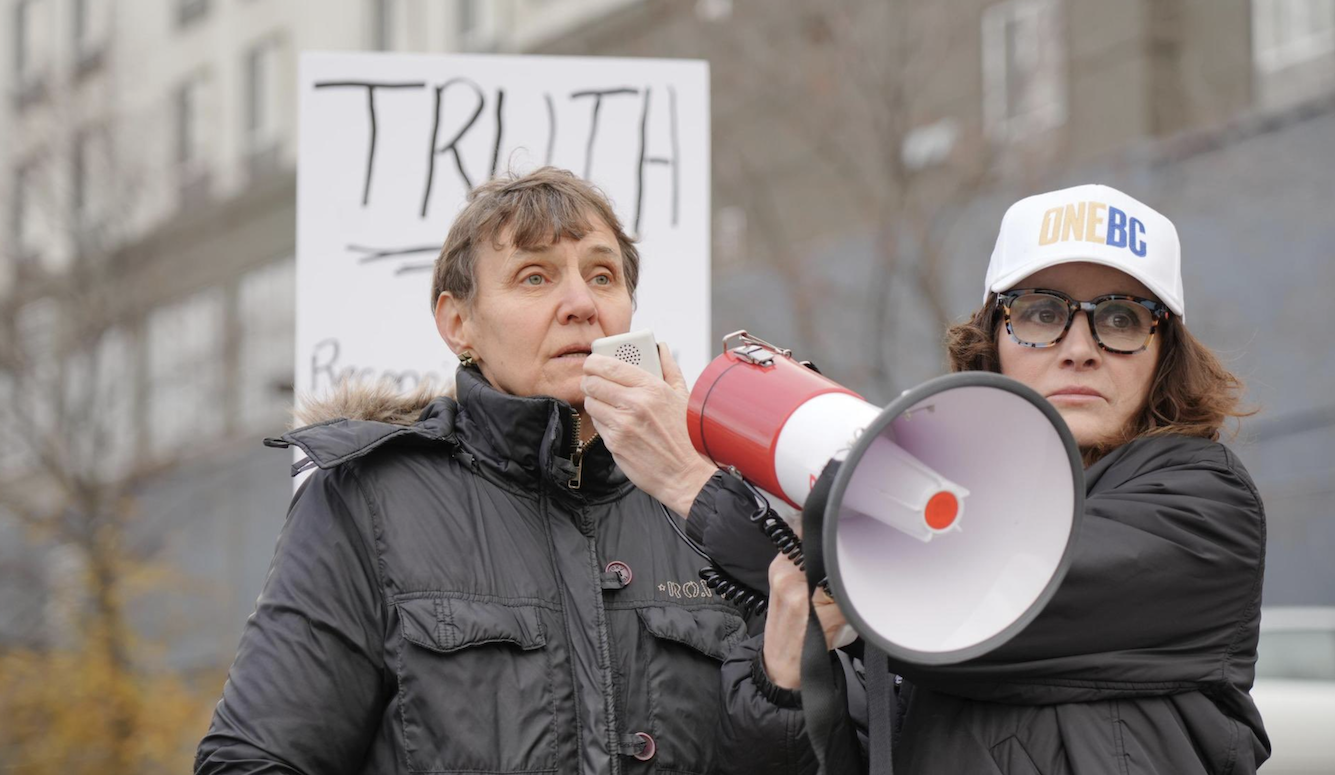With Stories Like These
With Stories Like These, Who Needs Talent? Part IV: The Sadia Shepard Incident
Many of their writers seem unable to conceive of life outside of a closed system controlled by a large bureaucracy.

his is the final part of a 4-Part series of essays by the author, entitled “With Stories Like These, Who Needs Talent?” Part Three can be found here.
The New Yorker was founded in 1925 as a humour magazine with an arch, self-consciously sophisticated, cosmopolitan tone. It soon evolved into a general-interest weekly with a focus on fiction, literature, ‘high culture’ in general, and what is now known as long-form journalism. Under William Shawn (1907-1992), who edited the magazine from 1952 to 1987, the New Yorker became the best-known, most prestigious venue for short stories in the English-speaking world. Writers still aspire to have their work published there, even though fiction now rivals the poetry as the element of the magazine most frequently skipped by its 1.2 million readers.
Occasionally the New Yorker features stories by authors of genuinely classic stature: Vladimir Nabokov (1899-1977), Italo Calvino (1923-1985), Alice Munro (1931- ), Sir V. S. Naipaul (1932- ), and – most recently – Primo Levi (1919-1987), whose “Quaestio de Centauris” was published in the annual Fiction Issue in June 2015. More typically, the magazine’s finest short fiction has been by writers such as John Cheever (1912-1982), John Updike (1932-2009), J. D. Salinger (1919-2010), and Raymond Carver (1938-1988), to name the most famous contributors from the Shawn era. These are minor masters at best: in general, their stories do not survive translation, and are ultimately most valuable as glimpses of American life in the latter half of the twentieth century.
Recently, the New Yorker has started to slant towards superficially experimental, critical-theory-driven ‘postmodern’ fiction. The range of concerns has shifted somewhat to reflect the magazine’s increasingly progressive stances on social, political, and economic issues; though the intended audience remains the same as it always has been: upwardly mobile, socially insecure professionals. Such people usually enjoy a high level of education and liberal or left-leaning political views, and wish to associate themselves with cultural élites in New York City and/or the more prestigious universities, if only in their imagined lives. A high proportion of New Yorker readers appear to be schoolteachers, college lecturers, or postgraduate students; or at least this is the target audience for the fiction, now that this part of the magazine has been taken over by institutionalised Creative Writing.
New Yorker short stories rarely have an obvious impact on the broader culture; though there have been recent exceptions, most notably Kristen Roupenian’s “Cat Person” (11 December, 2017), which went viral online shortly after publication, and swiftly became one of the magazine’s most widely-read pieces of 2017. The story describes a brief, failed relationship between a 20-year-old girl and a 34-year-old man, and has been described by numerous online commentators as emblematic of Millennial women’s bad experiences with dating. Whilst not as compelling or well written as Katie Way’s blog piece for Babe.net on an anonymous photographer’s one-night stand with the comedian Aziz Ansari, it seems a feature of the same general cultural phenomenon. This is an isolated case of a New Yorker story with relatively wide appeal.
Latterly, New Yorker fiction has often centred around Creative Writing, although social issues are occasionally mentioned as a means of reassuring readers that the magazine’s writers and editors do indeed continue actively to oppose Donald Trump in various ways. John Edgar Wiseman’s story “Writing Teacher” (22 January, 2018) is narrated by a Creative Writing instructor. Colin Barrett’s “Whoever Is There, Come On Through” (1 January, 2018) features a would-be writer in Ireland who is discharged from hospital two weeks after Trump’s election; his first words are “Who won the US Election?” “Texas” by David Gates (15 January, 2018) is more generally institutional: one character is an artist who advertises a house for rent in the New York Review of Books; his tenants are a couple consisting of a husband who is a composer subsisting on a grant from the National Endowment for the Arts, and a wife who earned her MFA in Nonfiction from Columbia. Rachel Kushner’s “Stanville” (12 and 19 February, 2018) boasts as its main character an isolated man (probably a writer) who ends up teaching literature (rather than Creative Writing) in a women’s prison.
It would be instructive to count the number of recent New Yorker stories set in institutions that look like writers’ colonies and university Creative Writing departments. Many of their writers seem unable to conceive of life outside of a closed system controlled by a large bureaucracy.
Another recent New Yorker trend has been the essay-story. In Nicole Krauss’s “Seeing Ershadi” (5 March, 2018), the main character is a member of a dance company who watches a great many art-house movies; the story is essentially a fictionalised essay on the Iranian film director Abbas Kiarostami (1940-2016). The life of a dancer is made to sound remarkably like that of a procrastinating Creative Writing instructor’s; early in the story, the narrator develops tendinitis, and so has a great deal of time to watch films and reflect on them at length. Zadie Smith’s essayistic story “The Lazy River” (18 and 25 December, 2017) is set at a luxurious all-inclusive resort hotel in southern Spain instead of (for once) a hospital, university, or arts organisation; the setting enables a few guilt-inducing brief encounters with African migrants, which seem to be the point of the story. “The Boundary” by Jhumpa Lahiri (29 January, 2018) is not quite an essay, but a writing exercise: the author learnt Italian whilst on a writer’s residency at the American Academy at Rome; this is only the latest story that she has written in basic Italian, then translated faithfully into English, for whatever reason.

The New Yorker has not abandoned conventional literature entirely. If a certain kind of pretentious, self-consciously ‘highbrow’ manner is increasingly prevalent (for example, the Nobel Prize winner J. M. Coetzee’s “The Dog,” 4 December, 2017), entertaining traditional short stories are still published sometimes. Jeffrey Eugenides’s “Bronze” (5 February, 2018) is the most aesthetically satisfying piece of fiction published in the magazine for some time. The narrative unfolds in 1978, and explores some of the nuances of New York’s gay culture through a meeting on a train between a stoned, flamboyantly queer-seeming undergraduate and a jaded thirty-eight-year-old actor who recognises something of his own former self in the lad’s narcissistic posturing. Eugenides overdoes the literary references somewhat (the material involving Latin poetry could have been handled with a lighter touch), but on the whole this is an absorbing story with convincing characters and a finely judged sense of atmosphere.
“Mrs. Crasthorpe” (26 February, 2018) is one of the last stories written by William Trevor (1928-2016), the distinguished Irish writer who first contributed to the magazine in 1977. Whilst nowhere near Trevor’s best work, “Mrs. Crasthorpe” typifies the ‘classic’ New Yorker short story. The fussy tone, precious language, and fixation on gentility might annoy many readers; but status obsession has always been part of the magazine’s appeal. There will always be an audience for snobbery, even at this shabby-genteel level.
Perhaps the most controversial New Yorker story of recent years is Sadia Shepard’s “Foreign-Returned” (8 January, 2018). Shepard, a documentary filmmaker, producer, and memoirist, has taught at Wesleyan University and in Columbia University’s Creative Writing program. The daughter of a white Protestant father from Colorado and a Pakistani mother, Shepard has written a book about herself and her identity, (The Girl From Foreign: A Memoir, 2008). As a filmmaker, her oeuvre is split between personal explorations of religion, identity, and Indian and Pakistani culture (In Search of the Bene Israel, 2008; The Other Half of Tomorrow, 2012; The Education of Mohammed Hussein, 2013) and a documentary about Vogue magazine (The September Issue, 2009), which she produced. “Foreign-Returned” is her first published piece of fiction.

The main characters in “Foreign-Returned” are all Pakistani Muslims. Hassan and his wife Sara are immigrants from Karachi who lived in New York for seven months until Hassan lost his job in an investment bank. Now they live in Connecticut in reduced circumstances. Hassan works as an analyst, and shares an office with Hina, the 22-year-old daughter of Pakistani immigrants. Unlike Hassan and his wife, Hina is a practising Muslim. Her headscarf is a prominent feature of the narrative.
Hassan and Sara are isolated, bored, and lonely in Connecticut. For a few summer months they are regular weekend visitors at the home of the Ahmeds, a successful Pakistani-American family who throw Sunday-afternoon parties where Hassan and Sara feel compelled to lie about their financial status and relative success to people who call Hassan “H-man” and call one another “bro” despite being Pakistani immigrants in their fifties. Hassan is particularly humiliated one afternoon when he is asked to help barbecue some chicken and it turns out that he doesn’t know how to do it.
In the autumn, Hassan and Sara stop receiving invitations to these parties, and later find out that Hina has replaced them as a regular guest of the Ahmeds’. At this point politics intrude: one day in October, Hina (a volunteer for the Democrats in her spare time) goes canvassing for Hillary Clinton’s presidential campaign and is harassed by some teenaged Trump supporters. In the aftermath of this mild assault, Hassan and Sara invite her for dinner. Sara has not thought to buy halal meat for their guest; Hina refuses to eat the steak Sara prepared. The evening is not a success.
After the election, Hassan and Sara find themselves back on the Ahmed’s guest list, at least for their “holiday party” during the Christmas season. Hina is also invited, and bothered by the fact that alcohol will be served at the party. She attends anyway. Hassan feels particularly out-of-place, as the least successful, worst-connected Pakistani immigrant among the men, many of whom are Trump supporters. Hassan goes to the kitchen and catches his wife in the middle of telling a face-saving lie; before he can expose her fabrication, Hina interrupts the conversation, claiming that she feels ill. Hassan is asked to take her home, even though he is too drunk to drive. He accompanies her home in a taxi; there are a few awkward not-quite-sexual moments; then Hina disappears into the bathroom and Hassan goes home, long before there is a threat of anything happening.
On Monday morning at work, Hina expresses her remorse that she spent time around people who were drinking, went home alone with a man who wasn’t married to her, and took off her headscarf in front of him. Then she tells Hassan the story of her life, and how she turned down a prospective husband when she was twenty. Two weeks later she is promoted to a managerial position, and Hassan never sees her again. He and Sara end up moving back to Karachi.
“Foreign-Returned” is not an impressive story. The dialogue is stiff and awkward; the characters and situations are under-imagined; there is a certain smoothness to the writing, but individual scenes are choppy, and little of the action is emotionally convincing. The New Yorker appears to have published this work for its ideological correctness rather than any obvious intrinsic qualities.
On 1 January, 2018, the New Yorker’s fiction editor Deborah Treisman published a revealing interview with Sadia Shepard entitled “Sadia Shepard on the Nuances of Immigration and Cultural Identity.” Shepard’s motivation for writing this story seems to be entirely political. This discussion is not nearly as interesting as the one sparked by Treisman’s second-last question about literary influences.
Shepard claims to have been influenced by Saadat Hasan Manto (1912-1955) and Qurratulain Hyder (1927-2007), famous Pakistani writers whose names are vaguely dropped as lip-service to “cultural identity” issues. Shepard’s only visible influence is the Paris-based Canadian writer Mavis Gallant (1922-2014). She admits as much to Treisman:
This story owes a great debt to one of my favorite short-story writers, Mavis Gallant, and specifically to her story “The Ice Wagon Going Down the Street.” “Ice Wagon” is a story that I return to year after year, trying to put my finger on what the peculiar alchemy between her characters is and why the story works the way that it does. I remember reading Gallant’s story—which is largely about Canadians working in Geneva—and thinking, This feels so Pakistani. Gallant’s ability to create a fictional world that conveys a sense of truth that feels universal, or that might be applicable to a completely different context, is incredibly exciting to me.
This praise does not quite ring true, and demands investigation.
Gallant is arguably the archetypical writer of ‘classic’ New Yorker short stories. She is keenly observant when it comes to social nuances and status anxieties; her work tends to fixate on isolation, thwarted ambition, and people whose reputations are at best precarious. It might be most convenient to think of her as a less gifted cousin to Alice Munro. Gallant’s stories often feel like extended series of impressions; she gathers the materials for an excellent story, but then fails to organise it into a proper narrative. Her stories have come to be thought of as exemplary in Creative Writing circles, even though they have failed to captivate many readers, except for writers of shabby-genteel autobiographical fiction. Her work is comforting to would-be authors with limited aspirations.
“The Ice Wagon Going Down The Street” was first published in the New Yorker on 14 December, 1963. The main characters are Peter and Sheilah Frazier, a couple who spent nine years in Europe and the Far East. Peter comes from a once-prominent Toronto family; Sheilah is an ex-model from Liverpool whose family were “rat-poor.” The story unfolds as an extended flashback.
Peter and Sheilah spent a few months in Paris squandering a small inheritance; then they settled in a dingy flat in Geneva, where Peter found a mediocre job as a filing clerk. During their first summer there they were regular weekend guests of the Burleighs, successful Canadian emigrants who eventually dropped them. Peter ended up sharing an office with Agnes Brusen, an awkward, silent, devoutly Protestant girl from Saskatchewan who turned out to be friendly with the Burleighs. When Peter and Sheilah invited her for dinner at their flat, she stubbornly refused to eat the lobster Sheila prepared. The evening was not a success.
At a Mardi Gras party at the Burleighs’ home, Agnes embarrassed herself, and Peter took her home. There was a not-quite-sexual encounter; Agnes shared various details of her home life in Saskatchewan. The following Monday, Agnes expressed her remorse to Peter that she went to a party where alcohol was served. Again she dwelt on her former home life. Her memories of waking up early and seeing an ice wagon go down the street stuck in Peter’s mind, even after he and Sheilah left Geneva.
“The Ice Wagon Going Down The Street” is by no standard a masterpiece; thus it seems strange that Shepard has essentially copied it scene for scene in “Foreign-Returned.” Agnes Brustein becomes Hina; the Burleighs become the Ahmeds; Peter and Sheilah from Toronto transform into Hassan and Sara from Karachi. Agnes’s Bible and framed degree certificate from the University of Saskatchewan become Hina’s Koran and accounting degree from the State University of New York at Albany. Some of Gallant’s dialogue is even lifted almost verbatim from the original. The only original element of Shepard’s story is the scene where Hina is “assaulted” by Trump supporters; otherwise Shepard has taken “The Ice Wagon Going Down The Street” and crudely changed settings and incidental details, often without stopping to consider whether these transformations make sense.
Francine Prose, a novelist well-known in the Creative Writing world, drew attention to Shepard’s apparent plagiarism in a series of public Facebook posts on 7th and 8th January (here, here, and here). She also wrote a letter to the editors of the New Yorker and this gets to the heart of her concerns:
Shepard, in an interview with the fiction editor Deborah Treisman, acknowledges a “great debt” to the Gallant story, but the correspondences far exceed the bounds of “debt,” and even of “homage,” or of a “translation” into a different ethnicity and historical period. Is it really acceptable to change the names and the identities of fictional characters and then claim the story as one’s own original work? Why, then, do we bother having copyright laws?
The New Yorker does not seem to have shared her worries; beneath Prose’s letter they published a response by Shepard (“Prose’s assertions reflect both a profound misrepresentation of my work and a refusal to acknowledge the central role that cultural identity plays in my story”), as well as the following words by Jess Row, a Creative Writing instructor at the College of New Jersey:
As is usually the case when a literary debate erupts, we’re not talking about the mechanics of story composition; this is a conversation about racial and cultural power and prestige. Shepard’s critics have accused her of plagiarizing Gallant’s story, while refusing to admit that to transpose a work’s cultural setting, or racial perspective, while preserving its plot is a long-standing, valid, and increasingly vital extension of Ezra Pound’s command to “make it new.” This denies both Shepard and Gallant the respect they deserve. Gallant wrote a masterly story that embodies a certain time, place, and perspective; Shepard, who discovered it decades later, found a way to bring it to life again, putting the same human frailties into a different context. The real scandal here is the proprietary rage of Shepard’s critics, who insist that she has no right to this material. As if they were the ones in charge. [emphasis added]
The published replies are harsh enough in their accusations; the comments under Prose’s Facebook posts are shocking, and worth reading in full for what they reveal about an ugly, hysterical literary culture.
The fiercest attacks on Prose come from Creative Writing instructors: Randa Jarrar (Professor of Creative Writing at California State University, Fresno), Porochista Khakpour (MFA faculty member at the Vermont College of Fine Arts), and Alexander Chee (Associate Professor of Creative Writing at Dartmouth College), all of whom cry racism, several times, at great length. They may have vested interests: in a tetchy response to comments by the writer David J. Clarke on 8 January, Chee notes in passing that he and Khakpour helped Shepard “workshop” this story through multiple drafts over several years. This likely helps explain why Chee insists on comparing Shepard to famous writers such as Zadie Smith, whilst Khakpour reminds Prose that “I have a long history of being inexplicably bullied by older white women with very excellent reputations, no matter what they say or do.” Jarrar’s comments are the angriest; Chee’s, the most insidiously passive-aggressive; Khakpour’s are the longest and most self-pitying.
Anti-Prose rhetoric spilled onto other Facebook pages. The novelist Marlon James, who won the Booker Prize in 2015 and teaches Creative Writing at Macalester College, did not find the courage to name the object of his attack, although there seems to have been little “self-righteous venom being dished out on Sadia Shepard’s story” other than Prose’s measured comments. Most of the “self-righteous venom” was directed at Prose. The writer Lincoln Michel at least had the grace not to insult Prose as he absolved Shepard of blame or guilt in an article for Lithub entitled “Good Writers Borrow, Great Writers Remix.” Gina Apostol’s article “Francine Prose’s Problem” in the Los Angeles Review of Books on 17 January, 2018 begins with this:
Certain people are ill-read, and maybe they need a brown saviour to tell them how to read. This is the conclusion I have come to after looking at this non-controversy boiled up by writer Francine Prose — on Facebook, of course, where perhaps one should let non-controversies lie.
Apostol does not appear to know what ‘sui generis’ means; nor does she quite understand the term ‘trope.’ Both are used in her essay anyway, which also makes the claim that Jorge Luis Borges’s story “Pierre Menard, Author of the Quixote,” composed in 1939, is a “classic explication of a poststructuralist theory of reading” of the sort which was not actually developed until the mid-1960s (Roland Barthes’s essay “La Mort de l’Auteur,” which introduced poststructuralism to a wide audience, was published in 1967). (NB: Apostol is not a Creative Writing instructor, or part of a writers’ colony or university-based literary institution. She teaches English at the Fieldston School in New York, which charges $48,645 USD per annum in tuition and fees.)
It is difficult to find anyone in the world of institutionalised Creative Writing who will defend Prose’s criticisms of Shepard, at least in public. The people at the heart of this scandal all know one other, and are the only real audiences for each other’s work. Prose appears to have accidentally laid bare a system that is as absurd as it is incestuous, tyrannical, and corrupt. Luckily she is over seventy years old, otherwise charges of “racism,” “bullying,” and “exploitation of white privilege” might have ruined her writing career, were it not already essentially over. She will probably never be published again by the New Yorker.

Institutionalised Creative Writing at first glance seems like Paradise to the aspiring writer: a secure teaching job; a guaranteed comfortable place to write, along with ample leisure time; access to literary agents, publishers, fellowships, grants and prizes; health insurance and an excellent university pension plan. If only this system had not been swallowed up by the modern bureaucratic university, with its lax admissions standards, lack of critical or aesthetic standards, low skill levels, ignorant personnel, exhausting discussions about critical theory, frightening ideological lynch mobs, and overall tendency towards mediocrity. Institutionalised Creative Writing has helped make contemporary literature as irrelevant and pointless as the study of contemporary literature, to the point where it is roughly as appealing to general readers as works of postmodern academic research.
Award-winning professional writers are now reduced to defending talentless peers who rip off the work of predecessors who weren’t particularly appealing to begin with. Any attempt to expose misconduct on the scale of Sadia Shepard’s will inevitably end in scream-rage and vitriol, as the Creative Writing ‘establishment’ desperately circle their wagons, subjecting whistle-blowers to vitriolic assaults by angry women and passive-aggressive men. All this for books that have no readers, or any possibility of lasting importance; literature within this little world is reduced to autobiographical memoirs, idle speculations that leave no trace on the broader culture or in society, and work designed to offend as few social-justice witch-hunters as possible. This must be what Hell is like.
A sign of how irrelevant even the New Yorker’s short stories have become in the age of university-based institutionalised Creative Writing: nobody in the real world has heard of Francine Prose, Sadia Shepard, Mavis Gallant or any of this controversy. Nobody cares. This whole system is rotten, toxic, and fundamentally useless. It needs to die.






